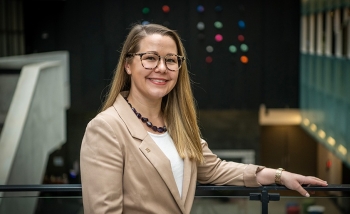Scientists from several institutions who work with Canada’s CHIME telescope have gotten much closer to revealing the explosive secrets behind a cosmic mystery known as “fast radio bursts,” thanks in great part to ingenious software developed by researchers at Perimeter Institute.
Since their discovery in 2007, fast radio bursts (FRBs) have become one of the hottest topics in astrophysics.
“It seems every 30 years or so, there’s a new extreme astrophysical event that we don’t understand. FRBs have become a central unsolved problem for the 21st century,” says Kendrick Smith, one of the lead Perimeter researchers on the CHIME (Canadian Hydrogen Intensity Mapping Experiment) team. “They are at least a thousand times brighter than the brightest radio pulses we’ve ever seen in our galaxy, and the physics that produces them is not understood.”
Although FRBs are brilliant, they’re also rare, last for only a fraction of a second, and are unpredictable. Some bursts are one-offs, others repeat irregularly, and just one has been observed that flashes in a discernible pattern.
On April 28, 2020, a team of researchers discovered an FRB source in our own galaxy – all others that have been observed originate in far more distant regions of the universe. In one of several FRB-related studies published today in Nature, they report that the intensity of this radio burst was 3,000 times greater than that of any previously measured FRB, and that it appeared to originate from a type of celestial object known as a “magnetar.”
“This really gives weight to the theory suggesting that magnetars could be behind at least some FRBs,” said Pragya Chawla, one of the co-authors on the study and a senior PhD student in the Department of Physics at McGill University.
In light of these new discoveries, NASA released the above video explaining why magnetars make such good candidates to be the source of FRBs. (Credit: NASA’s Goddard Space Flight Center/Chris Smith (USRA))
FRBs are difficult to observe and study: Astronomers using traditional radio telescopes essentially need to be lucky, happening to be looking in the right direction at the right time, in order to register an FRB.
This is where CHIME comes in. Using a telescope located in the Okanagan Valley in British Columbia, CHIME has become a made-in-Canada success story, featuring a team of researchers from institutions across the country, including McGill University, the University of British Columbia, the University of Toronto, the National Research Council of Canada, and Perimeter Institute. The telescope uses Perimeter-developed software to make the search faster, broader, more flexible, and significantly less expensive.
“Thanks to CHIME’s novel design and the powerful software we’ve written, our FRB discovery rate is about 10 times higher than all the other telescopes in the world combined,” says Smith, who holds the Daniel Family James Peebles Chair at Perimeter Institute.
A standard radio telescope uses a parabolic reflector to focus radiation coming from distant objects into usable data. But the parabolic dish needs to be directed toward a specific object or region in order to observe it. CHIME uses a different approach, collecting unfocused radio waves from a broad swath of the sky, and deploying software algorithms in lieu of reflectors to create maps of radiation sources.
“We can repeat and vary the software process many times in parallel. We get the observing power of about 100 single telescopes, all looking at different parts of the sky,” Smith says. “The processing challenges are really immense. We have shipping containers full of computers on site to handle the huge amount of data.”
Despite the high computing demands, it’s still far less expensive to hunt for FRBs with CHIME than with traditional telescopes. As a result, CHIME researchers were at the forefront of this week's announcements about new observations and theories about the nature of FRBs – and will likely remain so for the foreseeable future.
While magnetars are a prime candidate for the source of FRBs, theoretical physicists are still working on models that could explain the specific phenomena CHIME and related telescopes have detected.
“We need more observations of these super-giant pulses to see if the theories hold up,” Smith says. “And I think we need to see a few more before we can really say for sure what’s happening.”
About the CHIME Fast Radio Burst Collaboration
CHIME/FRB is a collaboration of over 50 scientists led by McGill University, the University of British Columbia, the University of Toronto, the Perimeter Institute for Theoretical Physics, and the National Research Council of Canada (NRC). The $16-million investment for CHIME was provided by the Canada Foundation for Innovation and the governments of British Columbia, Ontario, and Quebec, with additional funding from the Dunlap Institute for Astronomy and Astrophysics, the Natural Sciences and Engineering Research Council, and the Canadian Institute for Advanced Research. The telescope is located in the mountains of British Columbia’s Okanagan Valley at the NRC’s Dominion Radio Astrophysical Observatory near Penticton. CHIME is an official Square Kilometre Array (SKA) pathfinder facility.
About PI
Perimeter Institute is the world’s largest research hub devoted to theoretical physics. The independent Institute was founded in 1999 to foster breakthroughs in the fundamental understanding of our universe, from the smallest particles to the entire cosmos. Research at Perimeter is motivated by the understanding that fundamental science advances human knowledge and catalyzes innovation, and that today’s theoretical physics is tomorrow’s technology. Located in the Region of Waterloo, the not-for-profit Institute is a unique public-private endeavour, including the Governments of Ontario and Canada, that enables cutting-edge research, trains the next generation of scientific pioneers, and shares the power of physics through award-winning educational outreach and public engagement.
You might be interested in



Spiralling light from M87’s supermassive black hole reveals strong magnetic fields
November 8, 2023